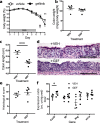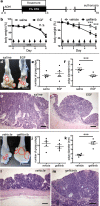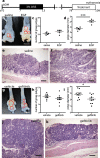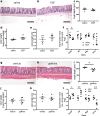Pharmacological activation of epidermal growth factor receptor signaling inhibits colitis-associated cancer in mice
- PMID: 29904166
- PMCID: PMC6002410
- DOI: 10.1038/s41598-018-27353-w
Pharmacological activation of epidermal growth factor receptor signaling inhibits colitis-associated cancer in mice
Abstract
Current treatments for inflammatory bowel disease (IBD) target the overactive immune response of the intestinal mucosa. However, epidermal growth factor (EGF), an activating ligand of the EGF receptor (EGFR), has been shown to induce disease remission through direct targeting of intestinal mucosal healing. Despite promising preclinical and clinical results, this EGFR-activating therapy has not progressed, in part due to the potential for carcinogenesis associated with long-term use and the increased risk of colitis-associated cancer (CAC) in IBD. Here we tested whether pharmacological modulation of EGFR altered outcomes of CAC in the murine azoxymethane/dextran sulfate sodium model. We found that administering EGF during the period of maximum colitis severity ("early"), coincident with the initiation and early promotion of tumors, improved outcomes of colitis and reduced tumor size. In contrast, daily EGF administration beginning ~2 months after tumor initiation ("late") increased tumor size. Administration of the EGFR kinase inhibitor gefitinib increased the tumor size when the drug was given early and decreased the tumor size when the drug was administered late. EGF administration not only reduced colonic cytokine and chemokine expression during injury, but also baseline chemokine expression in homeostasis. These results suggest that EGFR activation during acute bouts of colitis may reduce the long-term burden of CAC.
Conflict of interest statement
The authors declare no competing interests.
Figures






Similar articles
-
Dietary selenium deficiency exacerbates DSS-induced epithelial injury and AOM/DSS-induced tumorigenesis.PLoS One. 2013 Jul 4;8(7):e67845. doi: 10.1371/journal.pone.0067845. Print 2013. PLoS One. 2013. PMID: 23861820 Free PMC article.
-
Role of milk fat globule-epidermal growth factor 8 in colonic inflammation and carcinogenesis.J Gastroenterol. 2015 Aug;50(8):862-75. doi: 10.1007/s00535-014-1036-x. Epub 2015 Jan 18. J Gastroenterol. 2015. PMID: 25596854
-
EGFR-mediated macrophage activation promotes colitis-associated tumorigenesis.Oncogene. 2017 Jul 6;36(27):3807-3819. doi: 10.1038/onc.2017.23. Epub 2017 Mar 6. Oncogene. 2017. PMID: 28263971 Free PMC article.
-
Role of transient receptor potential vanilloid subtype 4 in the regulation of azoymethane/dextran sulphate sodium-induced colitis-associated cancer in mice.Eur J Pharmacol. 2020 Jan 15;867:172853. doi: 10.1016/j.ejphar.2019.172853. Epub 2019 Dec 10. Eur J Pharmacol. 2020. PMID: 31836532
-
Murine Model for Colitis-Associated Cancer of the Colon.Methods Mol Biol. 2016;1438:245-54. doi: 10.1007/978-1-4939-3661-8_14. Methods Mol Biol. 2016. PMID: 27150094 Free PMC article. Review.
Cited by
-
Improvement effect of compound Ento-PB on oxazolone-induced ulcerative colitis in rats.Acta Cir Bras. 2024 Sep 2;39:e395524. doi: 10.1590/acb395524. eCollection 2024. Acta Cir Bras. 2024. PMID: 39230095 Free PMC article.
-
Fluid supplementation accelerates epithelial repair during chemical colitis.PLoS One. 2019 Apr 19;14(4):e0215387. doi: 10.1371/journal.pone.0215387. eCollection 2019. PLoS One. 2019. PMID: 31002683 Free PMC article.
-
Casuarina glauca branchlets' extract as a potential treatment for ulcerative colitis: chemical composition, in silico and in vivo studies.Front Pharmacol. 2023 Dec 22;14:1322181. doi: 10.3389/fphar.2023.1322181. eCollection 2023. Front Pharmacol. 2023. PMID: 38196993 Free PMC article.
-
Moutai Distiller's grains Polyphenol extracts and rutin alleviate DSS-induced colitis in mice: Modulation of gut microbiota and intestinal barrier function (R2).Heliyon. 2023 Nov 11;9(11):e22186. doi: 10.1016/j.heliyon.2023.e22186. eCollection 2023 Nov. Heliyon. 2023. PMID: 38045189 Free PMC article.
-
Persistence of Lgr5+ colonic epithelial stem cells in mouse models of inflammatory bowel disease.Am J Physiol Gastrointest Liver Physiol. 2021 Sep 1;321(3):G308-G324. doi: 10.1152/ajpgi.00248.2020. Epub 2021 Jul 14. Am J Physiol Gastrointest Liver Physiol. 2021. PMID: 34260310 Free PMC article.
References
Publication types
MeSH terms
Substances
Grants and funding
LinkOut - more resources
Full Text Sources
Other Literature Sources
Molecular Biology Databases
Research Materials
Miscellaneous

